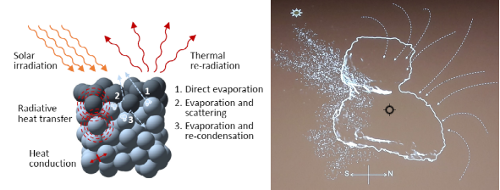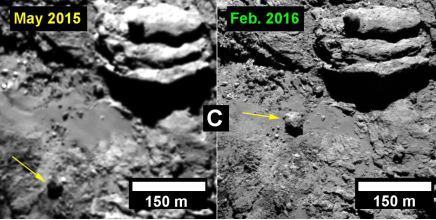Analysis of a particle in the surroundings of 67P
- 1Aurora Technology B.V for European Space Agency, ESA, Science operations SCI-OO, Villanueva de la cañada, Spain (jmarin@sciops.esa.int)
- 2European Space Agency, ESA, Science operations SCI-OO, Villanueva de la cañada, Spain
- 3Max Plank institute for solar system research Justus-von-Liebig-Weg 3, 37077 Göttingen, Germany
INTRODUCTION
Comet 67P/C-G is a dusty object. As it neared its closest approach to the Sun in late July and August 2015, instruments on Rosetta recorded a huge amount of dust enshrouding the comet. This is tied to the comet’s proximity to our parent star, its heat causing the comet’s nucleus to release gases into space, lifting the dust along [10]. Spectacular jets were also observed, blasting more dust away from the comet. This disturbed, ejected material forms the ‘coma’, the gaseous envelope encasing the comet’s nucleus, and can create a beautiful and distinctive tail. A single image from Rosetta’s OSIRIS instrument can contain hundreds of dust particles and grains surrounding the 4 km-wide comet nucleus.
The study of the dust behaviour is vital for understanding the global evolution of the comet and has direct consecuences in the research of the origins of the solar system. [1]
That helps for calculating the average mass loss rate per period. Calculations are not so simple since two situations may occur. The diurnal thermal cycle plus the irregularities in the shape of the comet produces a flow of particles from the southern hemisphere to the northern and most particles are redeposited. However some areas, like Hapi region, are eroded around 1.0± 0.5 m per orbit. Some other areas are growing with deposits of dust creating moving shifting dunes. It is believed the 95% of the ejected dust particles are falling back into the comet.

DUST ANALYSIS
A simple image of the OSIRIS instrument can contain hundreds of dust and grain particles around a 4km sphere around the core. The images above show the level of complexity when processing an image. Partly, most image sequences are processed manually [5]

The largest particle that has been observed on the surface of the comet is at least 20 x 30 x 40 m in size and displaced by a distance of 140 m [4].

BIG BOULDERS
Sometimes, even larger chunks of material left the surface of 67P/C-G – as shown here. The sizeable chunk in this view was spotted a few months ago by astrophotographer Jacint Roger from Spain, who mined the Rosetta archive, processed some of the data, and posted the finished images on Twitter as an animated GIF. He spotted the orbiting object ina sequence of images taken by Rosetta’s OSIRIS narrow-angle camera on 21 October 2015. At that time, the spacecraft was at over 400 km away from 67P/C-G’s centre. The trajectories have been calculated with Trackmate [7] and SPICE [9]. The location of the particles in the image list of the instrument is complicated due to the large number of particles that the images contain.
This particle was nicknamed Churymoon and at present its trajectory,orbital stability [8] is being studied as the consecuences of this discovery.
Following the methodology explained in [5], we can determine the size of Churymoon. Assuming that the photometric properties of the particle are the same as those of the nucleus, the total brightness of the particle divided by the total brightness of the comet per pixel gives us the fraction of pixels occupied by the particle.
The result, 3.9 meters in effective diameter, making Churymoon the largest 67P ejected particle ever detected.
* The size could be slightly overestimated by the calculation method used (ice or glitter in the core).
METHODOLOGY
There is no universal method for calculating dust trajectories in comets [7]. To date, studies have been carried out on: trajectories close to the surface of the comet [2], in the first image; calculation of trajectories through parallax between two cameras on board Rosetta [13], [15], [16], in the second image; and orbital determination for long periods of time [11], in the third image. To determine Churymoon's trajectory, neither of these methods would work individually, but a combination of them could be effective:
Using the satellite's displacement as a parallax source, in the fourth image, the position and velocity could be determined if the particle remains long enough in the camera's field of view
This method has been automatically tested on other image sequences, in the last illustration, effectively solving the trajectories. The biggest drawback is the large number of false positives (stars, cosmic rays, etc ...) that make real detections difficult.
CONCLUSSIONS
The implications of discovering a particle like this suggest new unknowns:
- These particles would describe trajectories following the comet's rotation. If so, there would be a restriction in determining the distance assuming a pure radial motion.
- If the particle production ratio of more than one meter was high enough, they could be relevant in calculating the total production of gas and dust. The search for possible future Churymoons is vital
- In principle, the contribution of these particles to the early disappearance of the near-earth asteroid population would be very small (~ 2.5%), but this is not conclusive.
BIBLIOGRAPHY
[1] Fulle et al 2016
[2] Agarwal et al 2016
[3] Guttler et al 2016
[4] El Maary et al 2017
[5] Guttler et al 2017
[6] Timenez et 2017
[7] Chenuard N et al 2014.
[8] Bertini et al 2015
[9] DOI: 10.5270/esa-tyidsbu
[10] Blum et al 2015
[11] Davidsson et al 2016
[12] Bertini et al 2017
[13] Drolshagen & Ott et al 2017
[14] Davidsson et al 2015
[15] Drolshagen et al 2017
[16] Ott et al 2017
[17] Ott (IMC 2016)
How to cite: Marín-Yaseli de la Parra, J., Kueppers, M., Roger Pérez, J., and Osiris Team, T.: Analysis of a particle in the surroundings of 67P, Europlanet Science Congress 2020, online, 21 September–9 Oct 2020, EPSC2020-801, https://doi.org/10.5194/epsc2020-801, 2020

